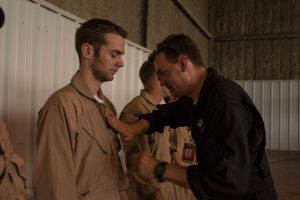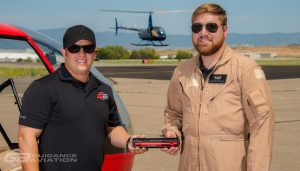
The 2014 AgustaWestland Safety Excellence Award recipient is Mr. Chris Horton, CFI-I, Manager of Flight Operations, Guidance Aviation. Helicopter Association International (HAI) announced the winners of the 2014 Salute to Excellence Awards, which “recognize those who, through either a single act or a lifetime of service and dedication, have exemplified the best the helicopter industry has to offer during the previous year….As helicopters serve the needs of society around the world, there are those in our industry who go above and beyond. “We are honored to be able to recognize their achievements,” said HAI President Matt Zuccaro.” [SOURCE: Rotor.org]
The AgustaWestland Safety Award acknowledges outstanding contributions in the promotion of safety and safety awareness throughout the international helicopter community.
“I can’t think of a harder working or more deserving pilot. Chris’s contributions are paramount to the success of the Guidance Aviation SMS,” stated John Stonecipher, President, CEO, Guidance Aviation.
About Chris Horton, CFI-I
Chris Horton, helicopter flight instructor and airplane pilot, discovered his passion for aviation safety as an undergraduate student at Embry-Riddle Aeronautical University. His knowledge of Aviation Safety and Safety Systems Management began early as he completed the ERAU minor in Safety Science. Chris focused heavily on accident mitigation and safety program management. Horton joined Guidance Aviation in 2010 and rapidly advanced to the position of Manager of Flight Operations. He is responsible for the daily operations of over 100 full time students, 20 flight instructors, and over 300 weekly flight operations. With schools in Prescott, Arizona and Baton Rouge, Louisiana, Guidance Aviation has a staff of just over 50 employees and a fleet of 16 helicopters.
His enthusiasm and intellect has allowed him to implement a methodical approach to SMS that changed the flight training culture at Guidance Aviation. With a limited budget, Chris has developed an introduction to SMS training program that focused on a “JUST” culture, safety reporting, and recognition of outstanding contributions to the Safety Management System. He established three safety stand down days per year, each focusing on current safety initiatives. His work developing a SMS was recognized through STARR Aviation and received public recognition as a leader in SMS training.
Guidance Aviation saw the fruits of Horton’s efforts and provided a greater platform for the growth of the SMS. As the Guidance Aviation SMS began to expand, Horton drafted the Emergency Response Plan and formed the Guidance Aviation Safety Board. The Board brings together stakeholders from each facet of the Guidance Aviation Program (Flight training, Operations, Maintenance, Administration, etc.), to review the Safety System. Together, the Board provides root cause analysis to accident / incident data, trend analysis, makes recommendations, and oversees the Safety Excellence Awards program. With Horton’s assistance, the Board began a safety matrix to assess and provide feedback to the Accountable Executives as to the health and success of the Safety Management System. With his recommendations, Guidance Aviation purchased the PRISM SMS solutions program and enhanced the Guidance SMS.
With help from Modern Technology Solutions, Inc., Horton drafted the first SMS Manual at Guidance, focusing on providing tools to instructors and students to involve safety into each training mission. He then facilitated the implementation of the SMS into student training. “Flight training is more than learning to fly the aircraft, but it is professionalism training, understanding of SMS, and learning safe habit patterns,” states Horton.
At the start of each new semester, a presentation is made to all students outlining the SMS program and emphasizing the importance of their involvement in the Safety System. In early 2012, Horton established the Student Safety Award that recognizes outstanding involvement in the SMS by students enrolled in any flight program. In this way, Horton helps students understand and apply the principles of SMS into everyday training.
In 2012, Horton was elected to his first term on the HAI Safety Committee. He has placed a great emphasis on ‘making safety sexy’ and authored a white paper emphasizing the need to put the Safety Committee on the social network scene.
He has been working with the Safety Committee to provide resources to pilots and operators who may not have the means to implement a full SMS, but have a desire to start down the SMS path. He is reaching out to his generation (the twenty-something year old pilot) through means she / he understands. While on the Safety Committee, Horton continues to take on new projects. He helped facilitate the 2013 Rotor Safety Challenge by seeking industry donations that would help encourage participation. He is now working with HAI staff to improve the Safety Committee presence at the 2014 Heli-Expo and hopes to see a greater out-reach to younger pilots. The Safety Committee has also asked Horton to work with the NTSB and other industry leaders to develop a program outlining the hazards of texting and flying or having a cellular phones in the cockpit.
As a FAASTeam representative, Horton focuses on the hazards of north-central Arizona flying. He has addressed high density altitude flying, human factors as it relates to heat and fatigue, operating in high training and traffic areas, MET Towers, and complacency. Horton has reached out to local pilots (helicopter and fixed-wing, alike) to provide insight to how helicopters operate in and around the airport environment. His goal is to help provide cost-effective tools to operators and pilots as they invest in their safety system.
Horton has taken courses in Safety Management Systems, Advanced Safety Management Systems, Human Factors: Threat and Error Management, Emergency Response, Accident Investigation, and Aircraft Survivability Analysis and Design.





